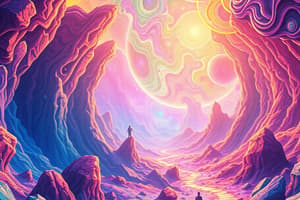Podcast
Questions and Answers
Which of the following is the primary mechanism of action for LSD?
Which of the following is the primary mechanism of action for LSD?
- Increasing the release of dopamine, norepinephrine, and serotonin.
- Acting as a serotonin receptor agonist (5-HT2A). (correct)
- Enhancing GABA activity in the brain.
- Blocking dopamine D2 receptors in the brain.
Which of the following best describes the origin of LSD?
Which of the following best describes the origin of LSD?
- A derivative of lysergic acid found in ergot fungus. (correct)
- A synthetic opioid.
- A synthetic derivative of amphetamine.
- A type of barbiturate.
Which of the following is a common effect associated with LSD use?
Which of the following is a common effect associated with LSD use?
- Increased appetite.
- Severe weight loss.
- Decreased heart rate and blood pressure.
- Euphoria or paranoia. (correct)
What is the typical onset time for the effects of LSD after ingestion?
What is the typical onset time for the effects of LSD after ingestion?
Under which legal act is LSD classified?
Under which legal act is LSD classified?
What analytical technique is commonly used to detect LSD in biological samples?
What analytical technique is commonly used to detect LSD in biological samples?
Which of the following is a characteristic chronic effect associated with LSD use?
Which of the following is a characteristic chronic effect associated with LSD use?
Which of the following best describes synesthesia, an effect associated with LSD use?
Which of the following best describes synesthesia, an effect associated with LSD use?
Which of the following is NOT a typical acute effect of LSD intoxication?
Which of the following is NOT a typical acute effect of LSD intoxication?
What is a key difference between the acute and chronic effects of LSD?
What is a key difference between the acute and chronic effects of LSD?
Flashcards
What is LSD?
What is LSD?
A potent hallucinogen derived from Ergot fungus (Claviceps purpurea).
LSD Mechanism of Action
LSD Mechanism of Action
Acts as a serotonin receptor agonist (5-HT2A) in the brain, causing altered perception and hallucinations.
LSD Chronic Effects
LSD Chronic Effects
Flashbacks (Hallucinogen Persisting Perception Disorder, HPPD), persistent psychosis, tolerance development.
LSD Legal Status
LSD Legal Status
Signup and view all the flashcards
What are Amphetamines?
What are Amphetamines?
Signup and view all the flashcards
Amphetamines: Mechanism of Action
Amphetamines: Mechanism of Action
Signup and view all the flashcards
What are Benzodiazepines?
What are Benzodiazepines?
Signup and view all the flashcards
Benzodiazepines: Mechanism of Action
Benzodiazepines: Mechanism of Action
Signup and view all the flashcards
What are Phenothiazines?
What are Phenothiazines?
Signup and view all the flashcards
Phenothiazines: Mechanism of Action
Phenothiazines: Mechanism of Action
Signup and view all the flashcards
Study Notes
LSD (Lysergic Acid Diethylamide)
- A potent hallucinogen comes from Ergot fungus (Claviceps purpurea)
- It belongs to the group of serotonergic psychedelics
- It is a derivative of lysergic acid chemically
- Acts as a serotonin receptor agonist (5-HT2A) in the brain
- It causes altered perception and hallucinations
Effects
- Hallucinations may be visual and auditory
- Alters perception of time and reality
- Synesthesia (mixing of senses, e.g., "hearing colors")
- Can cause euphoria or paranoia
- Increases heart rate and blood pressure
- Effects start to be felt within 30-90 minutes
- Effects last for 6-12 hours
Toxicology and Adverse Effects
- Acute effects include anxiety and panic attacks, delusions and paranoia, tachycardia, and hypertension
- Chronic effects include Flashbacks (Hallucinogen Persisting Perception Disorder, HPPD)
- May result in persistent psychosis in vulnerable individuals
- Tolerance develops quickly, but physical dependence does not
Forensic Relevance
- LSD is a Schedule I drug under the Narcotic Drugs and Psychotropic Substances Act (NDPS Act), 1985
- Can be detected in biological samples
- Chromatography: Thin Layer Chromatography (TLC), High-Performance Liquid Chromatography (HPLC)
- Spectroscopy: Mass Spectrometry (MS), UV-Vis Spectroscopy
Amphetamines
- Stimulants that affect the central nervous system (CNS)
Common Derivatives
- Amphetamine (Benzedrine)
- Methamphetamine (Crystal Meth)
- MDMA (Ecstasy)
- Increases the release of dopamine, norepinephrine, and serotonin in the brain
Effects
- Increased alertness and energy
- Euphoria
- Decreased appetite
- Increases heart rate and blood pressure
- High doses may cause aggression and paranoia
Toxicology and Adverse Effects
- Result in acute toxicity
- Hyperactivity
- Increased body temperature (hyperthermia)
- Anxiety, paranoia, hallucinations
- Results in chronic use
- Tolerance and dependence
- Psychosis similar to schizophrenia
- Severe weight loss
Forensic Relevance
- Detection: Can be done using Immunoassays (ELISA) and Gas Chromatography-Mass Spectrometry (GC-MS)
- Controlled under NDPS Act
- Methamphetamine is a Schedule II drug due to its high abuse potential
Benzodiazepines
- Are sedative-hypnotic drugs used in anxiety and insomnia treatment
Common Examples
- Diazepam (Valium)
- Lorazepam (Ativan)
- Alprazolam (Xanax)
- Clonazepam (Klonopin)
- Enhances the action of GABA (gamma-aminobutyric acid) in the brain and causes sedative effects
Effects
- Sedation and relaxation
- Muscle relaxation
- Reduced anxiety
- Sleep induction
Toxicology and Adverse Effects
- Acute overdose: Drowsiness, confusion
- Respiratory depression (severe in combination with alcohol)
- Chronic use: Tolerance and dependence
- Withdrawal symptoms: Anxiety, tremors, seizures
- Forensic Relevance
- Detection: Urine and blood analysis using GC-MS, LC-MS
- Some are Schedule IV drugs under the NDPS Act
Phenothiazines
- Antipsychotic medications that treats schizophrenia and other psychiatric disorders
Common Examples
- Chlorpromazine (Thorazine)
- Trifluoperazine
- Fluphenazine
- Blocks dopamine D2 receptors in the brain
Effects
- Reduces psychotic symptoms (hallucinations, delusions)
- Sedation
- Anti-emetic action (used in nausea/vomiting)
- Acute toxicity
- Hypotension, dizziness
- Blurred vision, dry mouth
Chronic Use
- Extrapyramidal symptoms (tremors, rigidity)
- Tardive dyskinesia (irreversible movement disorder)
- Neuroleptic Malignant Syndrome (NMS) – life-threatening condition with high fever, confusion, muscle rigidity
Forensic Relevance
- Detection: LC-MS, HPLC, Immunoassay
- Are prescription drugs, not commonly abused
Barbiturates
- CNS depressants used as sedatives, anesthetics, and anti-epileptics
Common Examples
- Phenobarbital (long-acting)
- Secobarbital (short-acting)
- Pentobarbital (short-acting)
- Enhances GABA activity, leading to sedation and hypnosis
Effects
- Sedation, hypnosis
- Reduced anxiety
- High doses can cause respiratory depression and coma
Toxicology and Adverse Effects
- Acute Toxicity: Respiratory depression
- Hypotension, bradycardia
- Coma, death in severe overdose
- Chronic Use: Dependence and withdrawal symptoms
- Cognitive impairment
- Urine/Blood tests can be done via GC-MS and Immunoassays
- Schedule II and III drugs under NDPS Act
Studying That Suits You
Use AI to generate personalized quizzes and flashcards to suit your learning preferences.




